Themed collection Spotlight Collection: Aggregation induced luminescence of metal complexes

Aggregation induced luminescence of metal complexes: advances and applications
Guest editors Andrea Fermi, Paola Ceroni and Inamur Rahaman Laskar introduce this Spotlight Collection: Aggregation induced luminescence of metal complexes.

Dalton Trans., 2023,52, 10637-10638
https://doi.org/10.1039/D3DT90126B
Supramolecular coordination complexes (SCCs) with aggregation-induced emission for in vitro photodynamic therapy
Schematic illustration of the preparation of D-CN and MD-CN nanoparticles and the process of cell death after light irradiation.

Dalton Trans., 2023,52, 4296-4302
https://doi.org/10.1039/D2DT03855B
Cu(I) complexes with aggregation-induced emission for enhanced photodynamic antibacterial application
AIE-featured PEG-condensed Cu(I)-p-MBA aggregates (PCuA), showing enhanced photodynamic antibacterial activities, were developed in water.
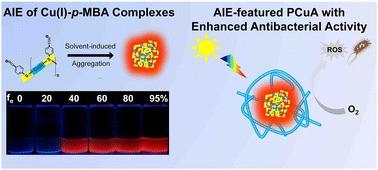
Dalton Trans., 2023,52, 2942-2947
https://doi.org/10.1039/D3DT00333G
Synthesis and photoluminescence of manganese(II) naphtylphosphonic diamide complexes
X-ray diffraction revealed tetrahedral geometry for manganese(II) halide complexes with napthylphosphonic diamide ligands. The photoluminescence spectra showed the superimposition of green Mn(II) emission with a band in the red range.
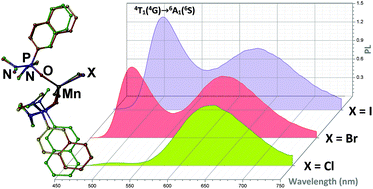
Dalton Trans., 2021,50, 3132-3136
https://doi.org/10.1039/D1DT00123J
A tetraphenylethene-based Pd2L4 metallacage with aggregation-induced emission and stimuli-responsive behavior
A tetraphenylethene-based Pd2L4 metallacage was self-assembled from four TPE-pyridine ligands with two Pd2+ ions. This metallacage exhibited a classical aggregation-induced emission property and stimuli-responsive behaviour.

Dalton Trans., 2020,49, 8051-8055
https://doi.org/10.1039/D0DT00469C
Effect of substituents on the 1O2 production and biological activity of (N^N^N)Pt(py) complexes
Pt(II) complexes with different degrees of fluorination at a pyridine ligand have been investigated as photosensitizers using the structural modifications of a series of tridentate N⁁N⁁N ligands. The compounds were evaluated as potential chemotherapeutic agents against A549 cell lines.

Dalton Trans., 2024,53, 2475-2486
https://doi.org/10.1039/D3DT04050J
Controlling the sensitivity and selectivity for the detection of nitro-based explosives by modulating the electronic substituents on the ligand of AIPE-active cyclometalated iridium(III) complexes
AIE active cyclometalated complexes of iridium(III) exhibiting high quantum yield showed selective and sensitive detection of TNT and TNP explosives through rationally choosing the appropriate electronic substituents on the cyclometalated ligand.
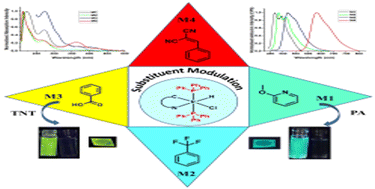
Dalton Trans., 2023,52, 14182-14193
https://doi.org/10.1039/D3DT02198J
PtII(C^N)(N-donor ligand)Cl-type complexes showing highly sensitive aggregation-induced phosphorescence emission (AIPE) behavior fulfilled by long-size ligands and a distorted molecular configuration
A series of four-coordinated PtII(C^N)(N-donor ligand)Cl-type complexes have been synthesized through a combination of long-size C^N-type and N-donor ligands.

Dalton Trans., 2023,52, 8927-8942
https://doi.org/10.1039/D3DT00238A
AIE-active cyclometalated iridium(III) complexes for the detection of lipopolysaccharides and wash-free imaging of bacteria
AIE-active cyclometalated iridium(III) polypyridyl complexes have been developed for rapid detection of bacterial lipopolysaccharide (LPS, also commonly known as endotoxin) and washing-free imaging of bacteria.

Dalton Trans., 2023,52, 7843-7853
https://doi.org/10.1039/D3DT00628J
Aggregation of phosphorescent Pd(II) and Pt(II) complexes with lipophilic counter-anions in non-polar solvents
Phosphorescent isostructural Pd(II) and Pt(II) aggregates involving metallophilic interactions in nonpolar achiral/chiral solvents have been extensively studied.

Dalton Trans., 2023,52, 5503-5513
https://doi.org/10.1039/D2DT03415H
Using a diphenyl-bi-(1,2,4-triazole) tricarbonylrhenium(I) complex with intramolecular π–π stacking interaction for efficient solid-state luminescence enhancement
The intramolecular π–π stacking interactions due to a minimalist ligand enhance the rigidity of the Re-BPTA complex,thus promoting remarkable solid-state luminescence properties.

Dalton Trans., 2023,52, 5453-5465
https://doi.org/10.1039/D2DT03573A
Aggregation-induced emission of a bis(imino)acenaphthene zinc complex with tetraphenylethene units
A bis(imino)acenaphthene (BIAN) zinc(II) complex with tetraphenylethene (TPE) units as bulky aryl groups has been designed and developed, and its photophysical properties in solution and in the solid state have been investigated.
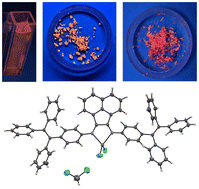
Dalton Trans., 2023,52, 5047-5055
https://doi.org/10.1039/D2DT03525A
An aggregation induced emission active bis-heteroleptic ruthenium(II) complex for luminescence light-up detection of pyrophosphate ions
An aggregation-induced emission active bis-heteroleptic(III) complex of an aminoethanol substituted 1,10-phenanthroline-based ligand has been developed for highly selective luminescence ‘light-up’ sensing of pyrophosphate ions.
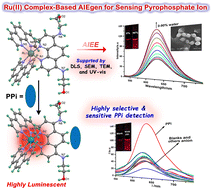
Dalton Trans., 2023,52, 2592-2602
https://doi.org/10.1039/D2DT03469G
Aqua-friendly organometallic Ir–Pt complexes: pH-responsive AIPE-guided imaging of bacterial cells
In this work, the aggregation-induced photoluminescence emission (AIPE) of three water-soluble heterobimetallic Ir–Pt complexes was reported with insight into their photophysical and electrochemical properties and imaging of bacterial cells.
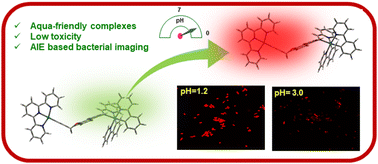
Dalton Trans., 2023,52, 2282-2292
https://doi.org/10.1039/D2DT03390A
Luminescent MOFs constructed by using butterfly-like AIE ligands
A series of butterfly-like isomers named oxacalix[2]naphthalene[2]pyrazine (ONP) were conveniently synthesized by a one-step catalyst-free reaction in a facile manner, and they exhibit typical characteristics of aggregation-induced emission (AIE).

Dalton Trans., 2023,52, 1913-1918
https://doi.org/10.1039/D2DT03382H
Aggregation-induced emission enhancement (AIEE) of tetrarhenium(I) metallacycles and their application as luminescent sensors for nitroaromatics and antibiotics
Luminescent nanoaggregates of Re(I) metallacycles were used as potential probes for the sensitive and selective detection of explosives and antibiotics that contain nitro groups.

Dalton Trans., 2023,52, 1939-1949
https://doi.org/10.1039/D2DT03408E
Self-assembled nanoparticles based on cationic mono-/AIE tetra-nuclear Ir(III) complexes: long wavelength absorption/near-infrared emission photosensitizers for photodynamic therapy
New cationic mono- and AIE tetra-nuclear Ir(III) complex-porphyrin conjugates and the corresponding carrier-free NP PSs by self-assembly methods without any auxiliary reagents, [TPP-Ir]+ NPs and [TPP-4Ir]4+ NPs, are obtained for highly efficient PDT.
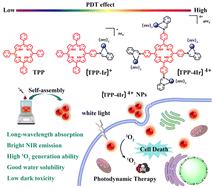
Dalton Trans., 2023,52, 1595-1601
https://doi.org/10.1039/D2DT03809A
AIE-active Ir(III) complexes as type-I dominant photosensitizers for efficient photodynamic therapy
Four new AIE-active Ir(III) complexes were synthesized. MFIrqa, SFIriqa and SFIrqa based NPs are shown to be good PSs in vitro for PDT through Type I ˙OH generation mechanism.
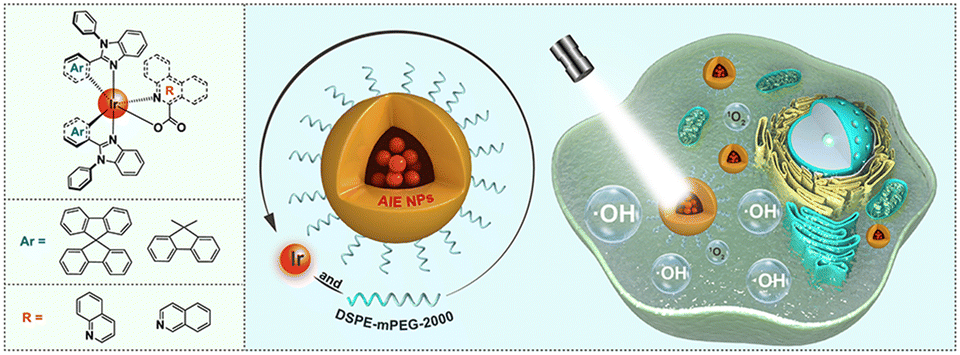
Dalton Trans., 2023,52, 1105-1112
https://doi.org/10.1039/D2DT03404B
AIPE-active cationic Ir(III) complexes for efficient detection of 2,4,6-trinitrophenol and oxygen
A novel AIPE-active diphenylamino-substituted cationic Ir(III) complex is highly sensitive to the detection of 2,4,6-trinitrophenol and oxygen.

Dalton Trans., 2023,52, 128-135
https://doi.org/10.1039/D2DT03537E
Ligand-regulated three-photon AIE properties of manganese(II) complexes for photodynamic therapy
Schematic diagram of the diagnostic system of fluorescent photosensitizer MD3.
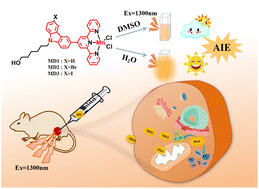
Dalton Trans., 2022,51, 16915-16920
https://doi.org/10.1039/D2DT02410A
AIE-active Ir(III) complexes functionalised with a cationic Schiff base ligand: synthesis, photophysical properties and applications in photodynamic therapy
Two AIE-active Ir(III) cationic complexes containing Schiff base ligands were synthesised. Ir-2-N+ NPs are shown to be good PSs in vitro for PDT.

Dalton Trans., 2022,51, 16119-16125
https://doi.org/10.1039/D2DT02960J
Luminescence color change of [3,4-difluoro-2,6-bis(5-methyl-2-pyridyl)phenyl-κ3N,C1,N′]cyanidoplatinum(II) by aggregation
A newly designed Pt(II) complex showing a variety of emission colors depending on the degree of stacking is capable of sensing chloroform vapor.
![Graphical abstract: Luminescence color change of [3,4-difluoro-2,6-bis(5-methyl-2-pyridyl)phenyl-κ3N,C1,N′]cyanidoplatinum(ii) by aggregation](/en/Image/Get?imageInfo.ImageType=GA&imageInfo.ImageIdentifier.ManuscriptID=D2DT02360A&imageInfo.ImageIdentifier.Year=2022)
Dalton Trans., 2022,51, 15830-15841
https://doi.org/10.1039/D2DT02360A
Multistimuli-responsive materials based on a zinc(II) complex with high-contrast and multicolor switching
A zinc(II) complex exhibits high-contrast and multicolor switching in response to mechanical, acid–base vapor and electrical stimulation under ambient light and 365 nm UV light.

Dalton Trans., 2022,51, 15370-15375
https://doi.org/10.1039/D2DT02435G
Dual crystalline–amorphous salen–metal complexes behave like nematic droplets with AIEgens vistas
The spacing of salen-type ligands by highly flexible permethylated bridges causes the derived coordination compounds to have unexpected material properties (e.g., liquid crystallinity, aggregation-induced emission or negative fluorescence anisotropy).
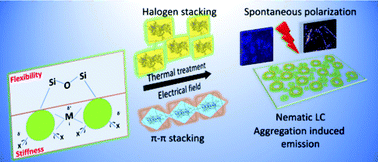
Dalton Trans., 2021,50, 13841-13858
https://doi.org/10.1039/D1DT01980E
First aggregation-induced emission of a Tb(III) luminophore based on modulation of ligand–ligand charge transfer bands
Herein the aggregation-induced emission (AIE) of a Tb(III) complex is reported for the first time.
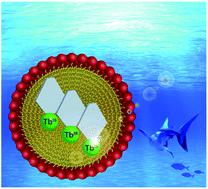
Dalton Trans., 2020,49, 2431-2436
https://doi.org/10.1039/D0DT00094A
Turn-on fluorescence in a pyridine-decorated tetraphenylethylene: the cooperative effect of coordination-driven rigidification and silver ion induced aggregation
A newly designed TPE ligand displayed a large fluorescence enhancement in the presence of silver ions in a dilute solution, leading to tunable fluorescence properties by simply mixing AIE and ACQ molecules.
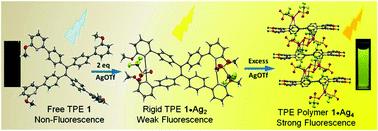
Dalton Trans., 2020,49, 1883-1890
https://doi.org/10.1039/C9DT03985F
Aggregation induced emission of a new naphthyridine-ethynyl–gold(I) complex as a potential tool for sensing guanosine nucleotides in aqueous media
A new organometallic alkynyl–gold(I) complex exhibiting aggregation induced emission is capable of sensing Guanosine nucleotides via complementary hydrogen bonding in aqueous media.

Dalton Trans., 2020,49, 171-178
https://doi.org/10.1039/C9DT04162A
Optimization of aggregation-induced phosphorescence enhancement in mononuclear tricarbonyl rhenium(I) complexes: the influence of steric hindrance and isomerism
Boosted phosphorescence: minor structural changes drastically improve the photoluminescence properties of these new rhenium complexes vs. parent compound.
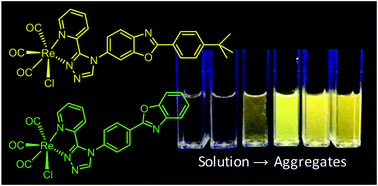
Dalton Trans., 2019,48, 15906-15916
https://doi.org/10.1039/C9DT02786F
A water-soluble cyclometalated iridium(III) complex for pH sensing based on aggregation-induced enhanced phosphorescence
The novel Na[Ir(ppy)2(SB-COO)] (Hppy = phenylpyridine; HSB-COOH = 4-carboxylanilinesalicylaldehyde Schiff base) in aqueous solution showed pH-responsive aggregation-induced enhanced phosphorescence (AIEP) by the formation of the protonated species [Ir(ppy)2(SB-COOH)].
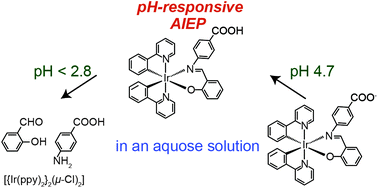
Dalton Trans., 2019,48, 8068-8075
https://doi.org/10.1039/C8DT04861D
1D-helical platinum(II) complexes bearing metal-induced chirality, aggregation-induced red phosphorescence, and circularly polarized luminescence
Binaphthyls-linked Pt(II) complexes with metal-induced chirality self-assemble to build 1D M or P helices and show aggregation/racemization-induced and circularly polarized luminescence.
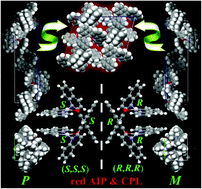
Dalton Trans., 2019,48, 4420-4428
https://doi.org/10.1039/C8DT03615B
A cationic organoiridium(III) complex-based AIEgen for selective light-up detection of rRNA and nucleolar staining
Cyclometalated Ir(III) complex-based AIEgen has been developed to selectively detect and stain the cell rRNA which has been revealed by in vitro PL studies and cell imaging experiment.
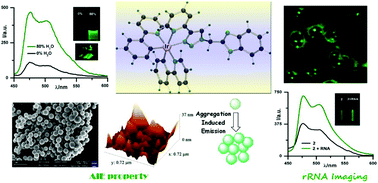
Dalton Trans., 2018,47, 11477-11490
https://doi.org/10.1039/C8DT02099J
A fluorescent turn-on probe for cyanide anion detection based on an AIE active cobalt(II) complex
A Co(II) complex based on an AIE-active tetraarylethylene ligand displays selective fluorescence enhancement in the presence of cyanide anion in aqueous solution.

Dalton Trans., 2018,47, 2079-2085
https://doi.org/10.1039/C7DT04242F
About this collection
Metal complexes have been known as luminescent materials for decades and still represent an extremely attractive class of materials due to their peculiar structure-related properties. As a consequence, they have found applications as responsive supramolecular motifs, sensors and photocatalysts. In the last 10 years, the emerging field of Aggregation-Induced Emission (AIE) demonstrated how a vast variety of compounds are able to switch from negligible emissive compounds in solutions to intensely luminescent materials upon aggregation.
This Spotlight Collection is focused on recent advances of AIE-active metal complexes published in Dalton Transactions, displaying the synthetic strategies for the preparation of new coordination motifs, their photophysical properties and their use as tuneable emissive materials in sensing-oriented and opto-electronic applications, aiming to define useful design principles for future improvements.
This collection is guest edited by:
Dr Andrea Fermi, University of Bologna, Italy
Professor Inamur R. Laskar, Birla Institute of Technology and Science, Pilani, India
Professor Paola Ceroni, Dalton Transactions Associate Editor, University of Bologna, Italy
Articles will be added to this themed collection as soon as possible after they are published. Please return to this page frequently to see the collection grow.
If you would like to contribute an article to this collection, please contact the Editorial Office at dalton-rsc@rsc.org with your proposed topic.